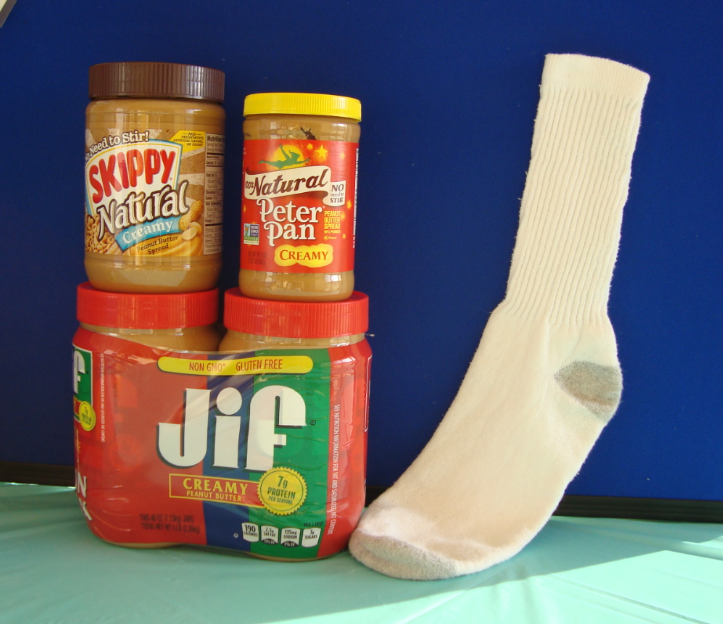
by Angela Hinkle | Oct 19, 2016
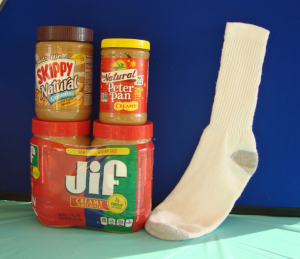 It’s that time of year: going to Friday night football games, decorating with pumpkins, welcoming in some cooler weather, and harvesting our locally grown peanuts and cotton. This also means it’s time for the Peanut Butter Challenge. We collect jars of unopened peanut butter throughout the Northwest Panhandle of Florida through November 23rd. (Contact your local UF/IFAS Extension office for details and peanut butter drop-off sites.)
It’s that time of year: going to Friday night football games, decorating with pumpkins, welcoming in some cooler weather, and harvesting our locally grown peanuts and cotton. This also means it’s time for the Peanut Butter Challenge. We collect jars of unopened peanut butter throughout the Northwest Panhandle of Florida through November 23rd. (Contact your local UF/IFAS Extension office for details and peanut butter drop-off sites.)
Peanut butter is a locally grown (okay, we don’t actually grow peanut butter, but we do grow the peanuts that make peanut butter), protein packed, tasty food that is safe to eat and store at room temperature. For these reasons, it is one of the most requested items at food pantries. After Thanksgiving, we will distribute to food pantries and organizations that give food to hungry families in need.
Okay, so what role do socks play in this? Cotton, another great locally grown agricultural product, is used to make socks. And even though UF/IFAS Extension does not have a “Sock Challenge,” the homeless and limited-resource families are often in desperate need of new white socks. There are plenty of shelters and schools who would really appreciate donations of clean new socks – any time of year.
So…Peanut Butter and Socks – they really are the Florida Panhandle’s perfect combination!
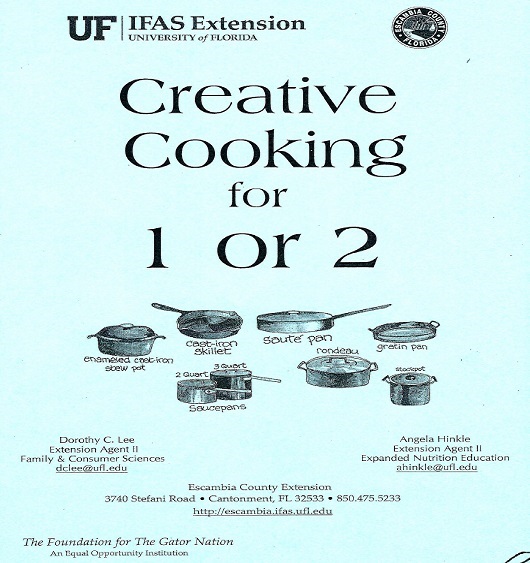
by Dorothy C. Lee | Oct 15, 2016
 A large and ever-growing number live the single life these days. You have a lot of company and something in common: freedom of choice. Cooking for one or two can be creative and nutritious. Whether you’re a novice cook or your family has grown and moved out, and, once again, you’re solo cooking…it still can be rewarding! Rewards? They can be summed up in one word: freedom—freedom to plan the meals you want and freedom to enjoy them when and where you want.
A large and ever-growing number live the single life these days. You have a lot of company and something in common: freedom of choice. Cooking for one or two can be creative and nutritious. Whether you’re a novice cook or your family has grown and moved out, and, once again, you’re solo cooking…it still can be rewarding! Rewards? They can be summed up in one word: freedom—freedom to plan the meals you want and freedom to enjoy them when and where you want.
Getting Ready to Cook for ONE or TWO
“Planning…shopping…storing…there’s so much to do even before I cook. Is it worth it for one or two?” Effort? Yes. But worth it? Definitely—who is more important to you? Call it “challenged” coupled with “just rewards.” Mostly, the challenge involves organization, planning, and nutrition. Here, then, is a Master Plan for meeting the challenges of “Solo-Cooking:”
Plan menu—preferably for a week’s worth of meals you’ll be preparing:
- Write out your menu
- A grocery list is a must
Survey your kitchen for basic cooking utensils:
- Non-stick skillet for stir-frying or pan broiling with little fat
- Vegetable steamer so you don’t boil away all the vitamins
- Two heavy-gauge stainless steel sauce pans: a small one for soups and sauces and a medium one for cooking pasta or steaming vegetables
- A paring knife for chopping and dicing and a large knife for cutting meats
- A wooden spoon that won’t damage non-stick pans
- Measuring cups and spoons
- Microwave cookware if you have a microwave oven (a microwave is a big plus for solo-cooking…it saves time and energy (your own and the local utility’s)
- Colander and wire whisk
Your cabinets don’t have to be bulging with exotic ingredients; just make sure you have basics on hand:
- Olive and vegetable oils for cooking and salad dressings
- Low-sodium bouillon and baking powder
- An assortment of herbs and spices
- Catsup and jelly
- Nonfat dry milk for recipes that call for milk
Frozen commercial microwave dinners make for quick and easy meals. Read nutrition labels and select low-fat meals that meet the following criteria:
- No more than 10 – 15 grams of fat
- 1,000 or less mg sodium per serving
- Frozen side dishes with 5 or less grams of fat and 400 or less mg sodium per serving
The frozen entrée also does not provide a balanced meal. Round it out with steamed or raw vegetables or a salad, whole grain bread, and fruit for dessert.
Once you have the basic strategies down and shopping under control, cooking for one or two can be a simple process. But what can you do if you’re faced with: (1) A tight budget and no food processor or microwave oven (2) Little time to cook and/or (3) An empty nest that makes mealtime a lonely time? Take Heart! You can meet these challenges with success. Here are some ways to make cooking for one or two easy and fun.
- Stir fry pre-chopped vegetables from the frozen section or from the grocery salad bar and serve with rice and beans.
- Steam pre-chopped vegetables and season with spices or low-sodium bouillon.
- Use a slow cooker…dump diced chicken, vegetables, and spices into the slow cooker in the morning and have a warm, homey aroma of a hearty, ready-to-eat stew in the evening.
- For breakfast, try a sandwich of thinly spread peanut butter with banana on whole wheat bread, bagel, or pita.
- Use your imagination—create super spuds. Top white or sweet potatoes with nonfat or lowfat yogurt or cheese, barbecue sauce, sautéed vegetables, or cream soups.
- Prepare extra when cooking rice, baked potatoes, oven meals, muffins, or pasta dishes. These can be refrigerated or frozen and used later.
Spicing up convenience foods…these foods are the salvation of many. But they often lack nutritional quality, texture, and home-cooked food flavor. You can boost nutrition and enhance the flavor by adding spices, vegetables, or meat. Try the following ideas or use your imagination!
- Add fresh onions and peppers to bottled or canned spaghetti sauce.
- Add a single-serving can of tuna to the pasta salad from the deli counter.
- Mix sliced vegetables with Rice-a-Roni. Or mix chili beans, tomato soup, chopped carrots, peppers, ¼ cup lowfat cheese, and onions with Spanish Rice-A-Roni for a hot, hearty goulash.
- Add grated lowfat cheese to quick-cooking grits.
- Add fresh fruit to plain lowfat yogurt.
- Add garbanzos instead of tuna or hamburger to Tuna and Hamburger Helpers.
For more ideas, check out:
Healthy Eating: Cooking for One
Healthy Cooking for 1 or 2
Cooking at Home Made Easy
Source: American Institute for Cancer Research
by Pam Allen | Oct 15, 2016
 Even though the weather is still warm, fall is right around the corner. Walk into any local grocery store and pumpkins are starting to show up. Pumpkins are a staple for the beginning of the fall season. Locally, you will see many varieties called pie or sugar pumpkins as well as carving pumpkins.
Even though the weather is still warm, fall is right around the corner. Walk into any local grocery store and pumpkins are starting to show up. Pumpkins are a staple for the beginning of the fall season. Locally, you will see many varieties called pie or sugar pumpkins as well as carving pumpkins.
The variety of pumpkin you select will depend on what you want to do with the pumpkin. Are you buying to carve a jack-o-lantern or make pumpkin pie? The bigger pumpkins are great for carving but the worst for cooking as they are stringy and very bland.
The best ones for baking and cooking with are sweet, flavorful, and have smooth-textured flesh. Varieties you will notice locally will be labeled for “pies” and are smaller and more compact in size.
After purchasing a pumpkin, it may be stored for many weeks in a well-ventilated place at room temperature. Once cut, you should store inside the refrigerator where it will keep for several days. For longer storage, prepare the pulp and freeze. This is excellent for pies and baked goods you want to make later.
Here are some interesting facts about pumpkins: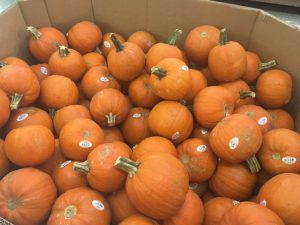
- Pumpkins are fruits (they contain seeds) and are a member of the cucurbit family which includes squash and cucumbers.
- Pumpkins are 90% water
- Pumpkins come in all sizes and weights.
- Pumpkins contain potassium and Vitamin A.
- The United States produces more than one billion pounds of pumpkins each year.
- Most pumpkins are orange but come in other colors too such as yellow, white, green, red and even tan.
- Most pumpkins weigh about 15 – 30 pounds.
- Pumpkin seeds can be roasted for a snack.
- It takes four to five months to grow pumpkins.
Freezing Pumpkin
Select a pumpkin labeled for cooking.
Preparation – Wash, cut into cooking-size sections and remove seeds. There are several ways to cook the pulp.
Cook in boiling water, in steam, or in an oven until soft. Remove by scraping the pulp from rind and mash. Discard the rind or use in your compost pile. To cool, place pan containing pumpkin in cold water and stir occasionally. Package in approved freezer container leaving ½-inch headspace. Label and date and place in freezer.
Roasted Pumpkin Seeds
Scoop out seeds from pumpkin. Remove pulp from seeds; Rinse and drain well. Rub seeds with a little oil. Spread on cookie sheet and bake at 300˚F for about 20 – 25 minutes or until brown. Stir often.
Pamela H. Allen, UF/IFAS Interim County Extension Director, Okaloosa County
by Laurie Osgood | Sep 25, 2016
FALL IS IN THE AIR, AND THAT MEANS FOOTBALL…AND CONCESSION STAND FOOD
Whether it is football, baseball or basketball season, they all have one thing in common, concession stands with their unhealthy food options. During a regular season, foods that are available in concession stands may be the only mealtime option for busy families and their athletes. Often, due to time and convenience, fans rely on the items that are sold at the concession stand for their families’ dinners.
On average, 73% of foods that are available in concession stands contain too much sugar, sodium, fat and calories. Although athletes may be burning calories on the field, eating unhealthy foods after a game may do more harm than good, leading to unbalanced diets consisting of too many calories, fat, and sugar.
BARRIER TO CHANGE:
The fear of lost revenue is perhaps the biggest obstacle to improving the nutritional value of concession stand foods. Traditionally, snacks and beverages sold in concession stands help generate crucial income for team essentials that are not covered by ever declining school sport budgets. There is a common misconception that healthy foods are more perishable and expensive, making booster clubs wary of tinkering with this critical revenue source.
SIMPLE SOLUTIONS THAT WORK
Small, simple modifications can be made to popular and profitable concession menu items without giving up revenue, or customer satisfaction. Therefore, a total menu overhaul is not necessary. Menus can be altered simply by adding 5-10 new healthy items and replacing unhealthy ingredients in existing menu items.
MARKETING A HEALTHY CONCESSION STAND:
According to E. Jerome McCarthy the “4 P’s of Implementation” can be an effective tool to market the healthier food and beverage options that are available to consumers. These strategies can help generate the profits that are essential to a team, without decreasing customer satisfaction.
4P’s of implementing a Marketing Plan:
- PRODUCT: Offer healthy snacks and beverages options along with existing menu items that are proven to sell. Make small changes to popular menu items to improve their nutritional value. Example: provide whole wheat buns on all sandwiches.
- PLACEMENT: Place healthier items at the top of menus or in clear view in order to make more healthful food more prominent and appealing. Example: prominently display healthier snacks in a decorative basket in full view of the customers and put candy behind the counter.
- PROMOTION: Promote healthy options by displaying promotional material and menus that promote the healthier choices that are available to families.
- PRICE: Make the healthier options more affordable than the unhealthy options-creating a cost-neutral outcome for the booster club. Example: price bottled water and 100% juices lower than soda.
Here is an example of a mock menu:
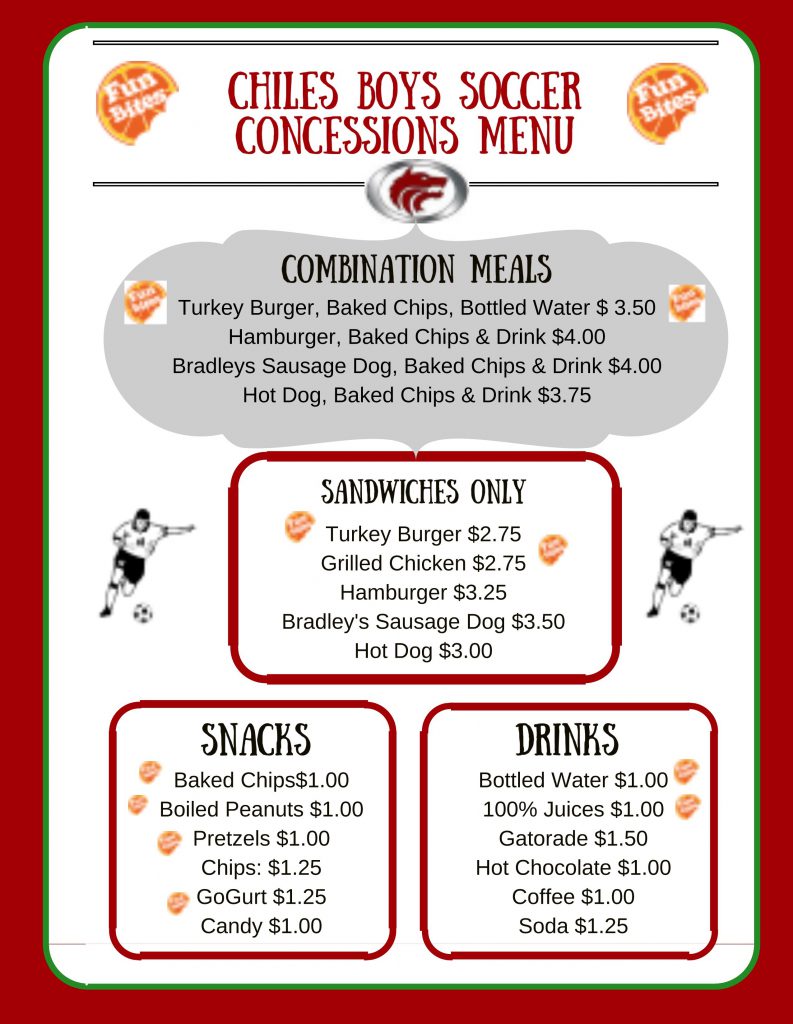
TIME FOR A HEALTHY CHANGE
Concession stands will always be a part of most high school sporting events. Therefore it is time to overhaul concession stand fare. Simple modifications can include offering 5-10 new healthy items along with replacing unhealthy ingredients in popular options without fear of losing sales and customer satisfaction.
WANT MORE INFORMATION?
The Family and Consumer Sciences (FCS) Agent at the Gadsden County UF/IFAS Extension office may have more information on food labeling or classes for you to attend. Also, a registered dietitian (RD) can provide you with reliable information.
REFERENCES:
- Journal of Public Health (2014, March 12) Laroche, H., Ford, C., Hansen, C., Cai, X., Just, D., Hanks, A., & Wansik, B. Concession stand makeovers: A pilot study of offering healthy foods at high school concession stands.
- Castle, J. (2015, July 14). REAL MOM NUTRITION BLOG: It’s Time to Build a Healthy Concession Stand – Jill Castle. http://jillcastle.com/young-athletes/build-healthy-concession-stand/
- US News and World Report: June 29, 2012. Retrieved from http://health.usnews.com/health-news/news/articles/2012/06/29/young-athletes-face-unhealthy-food-choices-parents-say
FOOTNOTES
Laurie B. Osgood, Family and Consumer Sciences Agent, Gadsden County Extension, UF/IFAS Extension, Quincy, FL 32351 (850) 662-3287 Osgoodlb@ufl.edu
The Institute of Food and Agricultural Sciences (IFAS) is an Equal Opportunity Institution authorized to provide research, educational information and other services only to individuals and institutions that function with non-discrimination with respect to race, creed, color, religion, age, disability, sex, sexual orientation, marital status, national origin, political opinions or affiliations. For more information on obtaining other UF/IFAS Extension publications, contact your county’s UF/IFAS Extension office.
U.S. Department of Agriculture, UF/IFAS Extension Service, University of Florida, IFAS, Florida A & M University Cooperative Extension Program, and Boards of County Commissioners Cooperating. Nick T. Place, dean for UF/IFAS Extension.
by Shelley Swenson | Sep 25, 2016
 Would you agree that kids get plenty of candy while trick or treating? Wouldn’t it be fun this year to focus on Halloween fun instead? Here are some ideas for parents, grandparents, adopted grandparents, teachers and neighbors to enjoy a Halloween celebration that does not focus on candy!
Would you agree that kids get plenty of candy while trick or treating? Wouldn’t it be fun this year to focus on Halloween fun instead? Here are some ideas for parents, grandparents, adopted grandparents, teachers and neighbors to enjoy a Halloween celebration that does not focus on candy!
- Focus on the costumes both for the children in your life as well as how you might choose to dress when you greet children as you receive them when they come to your home.
- If you live in a neighborhood, put together a costume parade so that everyone can see and appreciate the uniqueness of each child and their costume.
- Instead of candy, try giving small toys like stickers, small plastic spiders or ghosts, spooky plastic rings, chalk, fat pencils or crayons, small coloring books, bubbles or false teeth.
- Decorate pillowcases with your children for their trick-or-treat outing. This just extends the fun of the evening and encourages creativity.
- Food snacks worth giving include:
- Small containers of apple cider
- Roasted pumpkin seeds
- Small oranges
- Commercially wrapped baby carrots
- Mini-packages of dried fruit
- Packages of whole grain crackers with cheese
What is behind these suggestions? Typically, foods for Halloween include lots of candy. So what’s the harm? There is nothing wrong with an occasional treat, but unhealthy choices have become the norm rather than the exception. Parties, food fundraisers, vending machines, and school parties constantly expose children to high-fat, high-sugar, and low-nutrient choices.
Overall our children’s eating habits are poor. Most children do not eat enough fruits, vegetables or whole grains. Obesity rates among children are on the rise, with serious health consequences. Constant exposure to low-nutrient food makes it difficult for children to learn how to make healthy food choices. By providing children with nutritious choices whenever food is available, including Halloween, we can positively influence children’s eating habits.
Remember, children need to receive consistent messages that their food choices are important. What do you think? Are you willing to make some changes?
Happy Halloween!

 It’s that time of year: going to Friday night football games, decorating with pumpkins, welcoming in some cooler weather, and harvesting our locally grown peanuts and cotton. This also means it’s time for the Peanut Butter Challenge. We collect jars of unopened peanut butter throughout the Northwest Panhandle of Florida through November 23rd. (Contact your local UF/IFAS Extension office for details and peanut butter drop-off sites.)
It’s that time of year: going to Friday night football games, decorating with pumpkins, welcoming in some cooler weather, and harvesting our locally grown peanuts and cotton. This also means it’s time for the Peanut Butter Challenge. We collect jars of unopened peanut butter throughout the Northwest Panhandle of Florida through November 23rd. (Contact your local UF/IFAS Extension office for details and peanut butter drop-off sites.)





